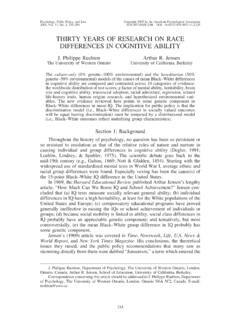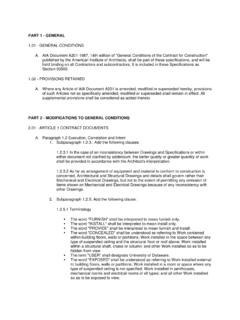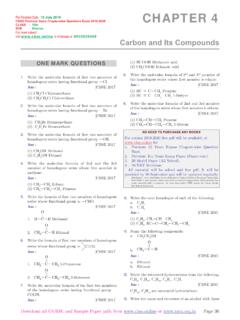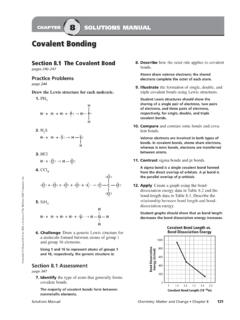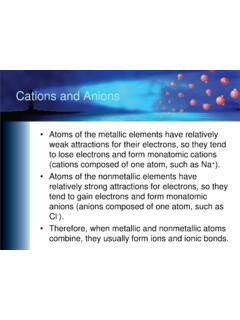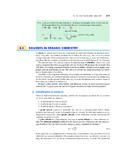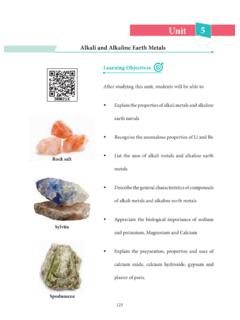Transcription of Chapter 7 Electron Configuration and the Periodic Table
1 Chapter 7. Electron Configuration and the Periodic Table Copyright McGraw-Hill 2009 1. Development of the Periodic Table 1864 - John Newlands - Law of Octaves- every 8th element had similar properties when arranged by atomic masses (not true past Ca). 1869 - Dmitri Mendeleev & Lothar Meyer - independently proposed idea of periodicity (recurrence of properties). Copyright McGraw-Hill 2009 2. Mendeleev Grouped elements (66) according to properties Predicted properties for elements not yet discovered Though a good model, Mendeleev could not explain inconsistencies, for instance, all elements were not in order according to atomic mass Copyright McGraw-Hill 2009 3. 1913 - Henry Moseley explained the discrepancy Discovered correlation between number of protons (atomic number) and frequency of X rays generated Today, elements are arranged in order of increasing atomic number Copyright McGraw-Hill 2009 4.
2 Periodic Table by Dates of Discovery Copyright McGraw-Hill 2009 5. Essential Elements in the Human Body Copyright McGraw-Hill 2009 6. The Modern Periodic Table Copyright McGraw-Hill 2009 7. The Modern Periodic Table Classification of Elements Main group elements - representative elements Group 1A- 7A. Noble gases - Group 8A all have ns2np6 Configuration (exception-He). Transition elements - 1B, 3B - 8B d- block . Lanthanides/actinides - f-block . Copyright McGraw-Hill 2009 8. Periodic Table Colored Coded By Main Classifications Copyright McGraw-Hill 2009 9. Copyright McGraw-Hill 2009 10. Predicting properties Valence electrons are the outermost electrons and are involved in bonding Similarity of valence Electron configurations help predict chemical properties Group 1A, 2A and 8A all have similar properties to other members of their respective group Copyright McGraw-Hill 2009 11.
3 Groups 3A - 7A show considerable variation among properties from metallic to nonmetallic Transition metals do not always exhibit regular patterns in their Electron configurations but have some similarities as a whole such as colored compounds and multiple oxidation states. Copyright McGraw-Hill 2009 12. Representing Free Elements in Chemical Equations Metals are always represented by their empirical formulas (same as symbol for element). Nonmetals may be written as empirical formula (C) or as polyatomic molecules (H2, N2, O2, F2, Cl2, Br2, I2, and P4). Sulfur usually S instead of S8. Copyright McGraw-Hill 2009 13. Noble Gases all exist as isolated atoms, so use symbols (Xe, He, etc.). Metalloids are represented with empirical formulas (B, Si, Ge, etc.)
4 Copyright McGraw-Hill 2009 14. Effective Nuclear Charge Z (nuclear charge) = the number of protons in the nucleus of an atom Zeff (effective nuclear charge) = the magnitude of positive charge experienced by an Electron in the atom Zeff increases from left to right across a period; changes very little down a column Copyright McGraw-Hill 2009 15. Shielding occurs when an Electron in a many- Electron atom is partially shielded from the positive charge of the nucleus by other electrons in the atom. However, core electrons (inner electrons) shield the most and are constant across a period. Copyright McGraw-Hill 2009 16. Zeff = Z - . represents the shielding constant (greater than 0 but less than Z). Example: Li Be B C N.
5 Z 3 4 5 6 7. Zeff Copyright McGraw-Hill 2009 17. Periodic Trends in Properties of Elements Atomic radius: distance between nucleus of an atom and its valence shell Metallic radius: half the distance between nuclei of two adjacent, identical metal atoms Copyright McGraw-Hill 2009 18. Covalentradius: half the distance between adjacent, identical nuclei in a molecule Copyright McGraw-Hill 2009 19. Atomic Radii (pm) of the Elements Copyright McGraw-Hill 2009 20. Explain What do you notice about the atomic radius across a period? Why? (hint: Zeff). What do you notice about the atomic radius down a column? Why? (hint: n). Copyright McGraw-Hill 2009 21. What do you notice about the atomic radius across a period?
6 Why? (hint: Zeff). Atomic radius decreases from left to right across a period due to increasing Zeff. What do you notice about the atomic radius down a column? Why? (hint: n). Atomic radius increases down a column of the Periodic Table because the distance of the Electron from the nucleus increases as n increases. Copyright McGraw-Hill 2009 22. Ionization energy (IE): minimum energy needed to remove an Electron from an atom in the gas phase Representation: Na(g) Na+(g) + e . IE for this 1st ionization = kJ/mol In general, ionization energy increases as Zeff increases Exceptions occur due to the stability of specific Electron configurations Copyright McGraw-Hill 2009 23. IE1 (kJ/mol) Values for Main Group Elements Copyright McGraw-Hill 2009 24.
7 Periodic Trends in IE1. Copyright McGraw-Hill 2009 25. Explain What do you notice about the 1st IE. across a period? Why? (hint: Zeff). What do you notice about the 1st IE. down a column? Why? (hint: n). Copyright McGraw-Hill 2009 26. What do you notice about the 1st IE across a period? Why? (hint: Zeff). IE1 increases from left to right across a period due to increasing Zeff. What do you notice about the 1st IE down a column? Why? (hint: n). IE1 decreases down a column of the Periodic Table because the distance of the Electron from the nucleus increases as n increases. Copyright McGraw-Hill 2009 27. Explain What do you notice about the 1st IE. between 2A and 3A? Why? (hint: draw the Electron Configuration ).
8 What do you notice about the 1st IE. between 5A and 6A? Why? (hint: draw the Electron Configuration ). Copyright McGraw-Hill 2009 28. What do you notice about the 1st IE between 2A and 3A? Why? (hint: draw the Electron Configuration ). What do you notice about the 1st IE between 5A and 6A? Why? (hint: draw the Electron Configuration ). Copyright McGraw-Hill 2009 29. Multiple Ionizations: it takes more energy to remove the 2nd, 3rd, 4th, etc. Electron and much more energy to remove core electrons Why? Core electrons are closer to nucleus Core electrons experience greater Zeff Copyright McGraw-Hill 2009 30. Copyright McGraw-Hill 2009 31. Electron Affinity (EA): energy released when an atom in the gas phase accepts an Electron Representation: Cl(g) + e Cl (g).
9 EA for this equation kJ/mol energy released ( H = negative). Copyright McGraw-Hill 2009 32. EA (kJ/mol) Values for Main Group Elements Copyright McGraw-Hill 2009 33. Periodic Trends in EA. Copyright McGraw-Hill 2009 34. Periodic Interruptions in EA. Explained in much the same way as IE. except not the same elements! Copyright McGraw-Hill 2009 35. Metallic Character Metals Shiny, lustrous, malleable Good conductors Low IE (form cations). Form ionic compounds with chlorine Form basic, ionic compounds with oxygen Metallic character increases top to bottom in group and decreases left to right across a period Copyright McGraw-Hill 2009 36. Nonmetals Vary in color, not shiny Brittle Poor conductors Form acidic, molecular compounds with oxygen High EA (form anions).
10 Metalloids Properties between the metals and nonmetals Copyright McGraw-Hill 2009 37. Electron Configuration of Ions Follow Hund's rule and Pauli exclusion principle as for atoms Writing Electron configurations helps explain charges memorized earlier Copyright McGraw-Hill 2009 38. Ions of main group elements Noble gases (8A) almost completely unreactive due to Electron Configuration ns2np6 (except He 1s2). Main group elements tend to gain or lose electrons to become isoelectronic (same valence Electron Configuration as nearest noble gas). Copyright McGraw-Hill 2009 39. Na: 1s22s22p63s1 Na+ 1s22s22p6. Na: [Ne]3s1 Na+ [Ne]. (Na+ 10 electrons - isoelectronic with Ne). Cl: 1s22s22p63s23p5 Cl 1s22s22p63s23p6.




